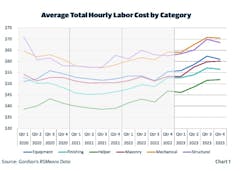The construction industry is facing a perfect storm in the labor arena. Not only is it harder to find workers, but employers are having to pay those they do hire – many underqualified – steadily higher wages. And to top it off, they’re squeezing less productivity out of that labor.
That’s the picture a few recent studies paint on labor issues in construction, a subject drawing more attention as construction services demand grows.
Beyond identifying the problems, the research presents possible remedies. They share common themes: invest in maximizing the capabilities of the workforce that exists; become more attractive to current and prospective workers; and fine-tune internal processes to improve productivity.
Stating a clear fact – construction is labor intensive and “contractors are in the labor management business” – FMI Corporation’s 2023 Construction Labor Productivity Study finds “labor productivity is a challenge for the construction industry, and it appears to be getting worse.” In 2022 alone, it says, contractors likely forfeited $30 to $40 billion of the $900 billion of construction put in place to labor inefficiencies. Its poll of 259 construction contractors, nearly half of whom were mechanical/electrical/plumbing contractors, found 45% saying productivity had slightly or significantly declined in the last 12-18 months. The last time FMI did a productivity study, in 2012, that number was 25%.
Since that study, the labor problem has grown more acute. And that’s amplifying the productivity challenge, which data shows has been worsening for decades, it says. Another study it did last year of talent issues in construction found 93% of respondents saying they can’t find the workers they need, most critically in field leadership. The problem of qualified labor overall, it says, is most pressing in the craft sector.
Field leadership is a critical element of the productivity puzzle because that is where execution of well-formulated strategies and tactics – many linked to labor utilization – intensely focused on profitable project outcomes is managed. “In FMI’s research and industry experience, the critical missing link is often early, in-depth involvement, engagement, and buy-in from field leaders,” the report notes.
The prospects for retention of quality field leadership, though, are not good, possibly compounding the labor shortage problem. The report found construction executives expecting 30% turnover for field managers over the next five years. That can be arrested partly through improved efforts to keep managers engaged and supported in the overarching mission of sustaining and improving productivity, which FMI says has a direct link to profitability. “At the company level, improving labor productivity by 6% to 10% can translate to a 2% to 3% increase to the bottom line— in many cases, a 50% to 100% improvement in profitability.”
But the urgent problem facing construction contractors is labor supply and cost, according to a recent ConstructConnect/Gordian study. In The Great Adaptation: Navigating the New Construction Labor Pool, the authors say new federal rules on construction labor will likely supercharge wage growth in the sector. Additionally, the emergence of more $1 billion-plus “mega” construction projects will sap labor supply and put upward pressure on wages (see Map above).
“It is important to realize that as the gap between supply and demand narrows, the rate of construction pay increases,” the report states. “Applying the knowledge of past dynamics and coupling it with our forward-looking understanding of labor supply makes it clear that labor wage growth (see Chart at right) is a structural problem for the industry.”
Part of the solution, the report says, is to better recruit and retain workers. Echoing the FMI report’s take on productivity – “businesses find themselves in the unenviable position of paying more per hour for labor while getting less output per labor hour” – the researchers point to improved in-house worker training and development; encouragement of worker longevity; more robust referral programs; expanded hiring of women; and investments in technology as proactive steps to address the labor problem.
“Firms that embrace structural change and implement modern technologies for recruiting, training and jobsite safety will see reductions in long-term labor costs,” the report says.
But construction contractors face a stubborn reality when it comes to labor supply, according to Associated General Contractors of America. In a member survey of 1,400 firms conducted in 2023, AGC found 68% of firms reporting that applicants lack the basic skills needed. That puts contractors in the vise of having to pay more to hire workers deficient in skills and bear the costs of training, with no assurances workers will stay. Thus, 85% of firms surveyed have open positions they’re trying to fill. Within that group, 88% are having trouble filling them, especially vital craft positions like electrical.
One bright spot in the survey: 91% of firms say their employees have the digital technology skills needed to help implement technologies that could improve labor productivity. Given the long-term labor supply outlook, technology might hold the ultimate key to addressing the industry’s labor challenges.





